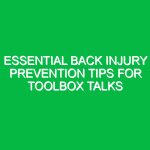In today’s fast-paced work environments, prioritizing health, safety, and Environment (HSE) practices has never been more critical. One of the cornerstones of effective HSE management is the use of personal Safety equipment (PSE). This article presents a comprehensive personal Safety equipment list that is essential for promoting safety and compliance in various industries. By understanding the importance of these tools, organizations can significantly reduce the risk of accidents and enhance the well-being of their workforce.
Understanding the Personal Safety Equipment List
The personal safety equipment list comprises various tools and devices designed to protect individuals from potential Hazards encountered in their work environment. These tools range from basic protective gear to specialized equipment tailored to specific risks associated with certain jobs. The relevance of a personal safety equipment list extends beyond compliance; it embodies a commitment to fostering a culture of safety and responsibility within the workplace.
Imagine a construction site bustling with activity. Heavy machinery operates alongside workers handling hazardous materials. Without a proper personal safety equipment list, the potential for accidents increases exponentially. Through the diligent application of appropriate Safety Gear, many workplace incidents can be prevented.
Key Components of Personal Safety Equipment
To ensure a robust safety culture, it is essential to understand the various components of a personal safety equipment list. Below, we break down the critical categories of safety equipment vital for HSE success.
1. Head Protection
- Hard Hats: Essential for safeguarding against falling objects, hard hats are a must in construction and industrial settings.
- Helmets: Specialized helmets may be required in high-risk environments, such as electrical work, to protect against Electrical Hazards.
2. Eye and Face Protection
- Safety Goggles: Protect against flying debris, chemicals, and radiation.
- Face Shields: Useful for additional protection during grinding, cutting, or when handling hazardous chemicals.
3. Hearing Protection
- Earplugs: Designed to reduce noise exposure in loud environments.
- Noise-Canceling Headphones: Provide an alternative for workers needing to communicate while protecting their hearing.
4. Respiratory Protection
- Dust Masks: Protect against dust and particulate inhalation.
- Respirators: Essential for environments with harmful gases or vapors, varying from half-masks to full-face respirators.
5. Hand and Arm Protection
- Gloves: The type of glove needed will depend on the specific Hazards. Options include cut-resistant, chemical-resistant, and heat-resistant gloves.
- Arm Shields: Provide additional protection against cuts and Burns.
6. Body Protection
- High-Visibility Vests: Particularly crucial in environments where workers are near moving vehicles.
- Coveralls: Protect against chemicals, dirt, and physical hazards.
7. Foot Protection
- Safety Boots: Steel-toed boots are essential for many industries to protect against heavy objects and punctures.
- Slip-Resistant Shoes: Important for preventing slips and falls in wet or oily environments.
8. Fall Protection Equipment
- Harnesses: Used in industries where workers are exposed to heights.
- Safety Nets: Provide additional Safety Measures for elevated work.
Best Practices for Implementing Personal Safety Equipment
Having a personal safety equipment list is only the first step; ensuring its effective implementation is crucial for safety success. Here are Best Practices for organizations:
1. Conduct a Risk Assessment
Before determining which personal safety equipment is necessary, conduct a thorough risk assessment of the work environment. Identify potential hazards and evaluate the risks associated with each role within the organization. This assessment will guide the selection of appropriate safety equipment.
2. Provide Training
Training employees on the proper use, maintenance, and limitations of their personal safety equipment is essential. Workers must understand how to properly wear and care for their equipment to maximize protection. Regular refresher courses can help maintain awareness and compliance.
3. Regular Equipment Inspections
Establish a schedule for regular inspections of all personal safety equipment. Ensure that equipment is not damaged and functions as intended. Replace any worn or outdated gear promptly to maintain safety Standards.
4. Encourage a Safety Culture
Fostering a culture of safety within the organization encourages employees to prioritize their well-being. Recognize and reward Safe Practices, and encourage open communication about safety concerns.
Real-Life Examples of Safety Equipment in Action
To illustrate the significance of personal safety equipment, consider the case of a construction worker named John. While working on a site without adequate safety gear, John experienced a near-miss incident when a tool fell from above. Fortunately, he was wearing a hard hat, which mitigated potential injury. This incident highlights the importance of following a comprehensive personal safety equipment list and underscores the necessity of proper training and risk assessments.
Regulations and Standards Governing Personal Safety Equipment
Various Regulations govern the use of personal safety equipment across industries. In the United States, the Occupational Safety and Health Administration (OSHA) sets forth guidelines for Personal Protective Equipment (PPE) under 29 CFR 1910. These regulations outline the requirements for employers to provide appropriate safety gear and ensure it is used effectively. Compliance with these regulations is not just a legal obligation; it is a critical component of Workplace Safety.
Organizations operating in different countries must familiarize themselves with local regulations and standards. For instance, ISO 45001 is an international standard for Occupational Health and safety management systems, promoting a safe and healthy work environment.
Conclusion
In summary, a comprehensive personal safety equipment list is vital for ensuring health, safety, and environmental success in any workplace. By understanding the various categories of safety equipment, implementing Best Practices, and adhering to regulations, organizations can effectively reduce workplace hazards and promote a culture of safety. The commitment to personal safety equipment not only protects workers but also enhances overall productivity and morale.
As we move forward, it is essential to continually evaluate and improve safety practices. By doing so, we create safer environments for all workers, ultimately leading to a healthier and more sustainable future.


